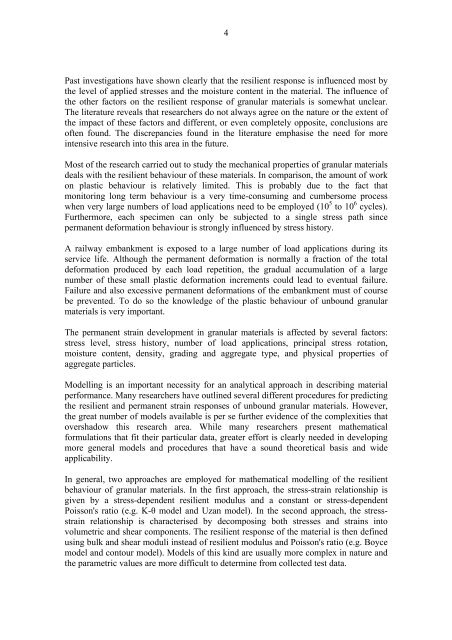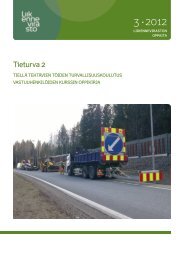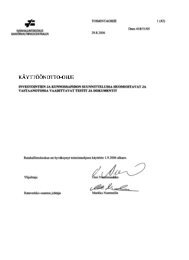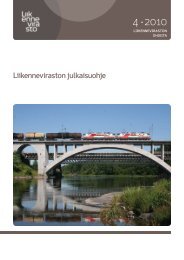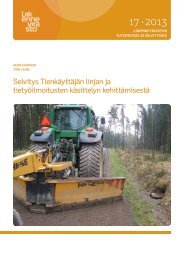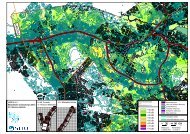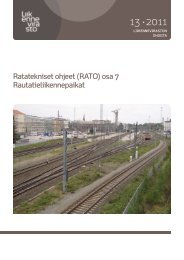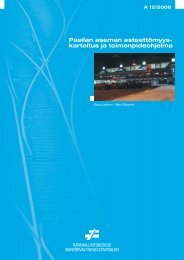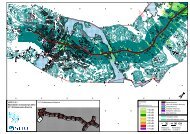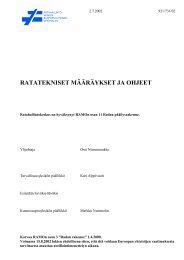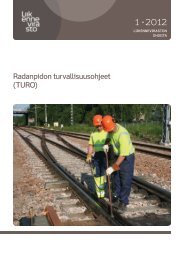Deformation behaviour of railway embankment ... - Liikennevirasto
Deformation behaviour of railway embankment ... - Liikennevirasto
Deformation behaviour of railway embankment ... - Liikennevirasto
Create successful ePaper yourself
Turn your PDF publications into a flip-book with our unique Google optimized e-Paper software.
4<br />
Past investigations have shown clearly that the resilient response is influenced most by<br />
the level <strong>of</strong> applied stresses and the moisture content in the material. The influence <strong>of</strong><br />
the other factors on the resilient response <strong>of</strong> granular materials is somewhat unclear.<br />
The literature reveals that researchers do not always agree on the nature or the extent <strong>of</strong><br />
the impact <strong>of</strong> these factors and different, or even completely opposite, conclusions are<br />
<strong>of</strong>ten found. The discrepancies found in the literature emphasise the need for more<br />
intensive research into this area in the future.<br />
Most <strong>of</strong> the research carried out to study the mechanical properties <strong>of</strong> granular materials<br />
deals with the resilient <strong>behaviour</strong> <strong>of</strong> these materials. In comparison, the amount <strong>of</strong> work<br />
on plastic <strong>behaviour</strong> is relatively limited. This is probably due to the fact that<br />
monitoring long term <strong>behaviour</strong> is a very time-consuming and cumbersome process<br />
when very large numbers <strong>of</strong> load applications need to be employed (10 5 to 10 6 cycles).<br />
Furthermore, each specimen can only be subjected to a single stress path since<br />
permanent deformation <strong>behaviour</strong> is strongly influenced by stress history.<br />
A <strong>railway</strong> <strong>embankment</strong> is exposed to a large number <strong>of</strong> load applications during its<br />
service life. Although the permanent deformation is normally a fraction <strong>of</strong> the total<br />
deformation produced by each load repetition, the gradual accumulation <strong>of</strong> a large<br />
number <strong>of</strong> these small plastic deformation increments could lead to eventual failure.<br />
Failure and also excessive permanent deformations <strong>of</strong> the <strong>embankment</strong> must <strong>of</strong> course<br />
be prevented. To do so the knowledge <strong>of</strong> the plastic <strong>behaviour</strong> <strong>of</strong> unbound granular<br />
materials is very important.<br />
The permanent strain development in granular materials is affected by several factors:<br />
stress level, stress history, number <strong>of</strong> load applications, principal stress rotation,<br />
moisture content, density, grading and aggregate type, and physical properties <strong>of</strong><br />
aggregate particles.<br />
Modelling is an important necessity for an analytical approach in describing material<br />
performance. Many researchers have outlined several different procedures for predicting<br />
the resilient and permanent strain responses <strong>of</strong> unbound granular materials. However,<br />
the great number <strong>of</strong> models available is per se further evidence <strong>of</strong> the complexities that<br />
overshadow this research area. While many researchers present mathematical<br />
formulations that fit their particular data, greater effort is clearly needed in developing<br />
more general models and procedures that have a sound theoretical basis and wide<br />
applicability.<br />
In general, two approaches are employed for mathematical modelling <strong>of</strong> the resilient<br />
<strong>behaviour</strong> <strong>of</strong> granular materials. In the first approach, the stress-strain relationship is<br />
given by a stress-dependent resilient modulus and a constant or stress-dependent<br />
Poisson's ratio (e.g. K-θ model and Uzan model). In the second approach, the stressstrain<br />
relationship is characterised by decomposing both stresses and strains into<br />
volumetric and shear components. The resilient response <strong>of</strong> the material is then defined<br />
using bulk and shear moduli instead <strong>of</strong> resilient modulus and Poisson's ratio (e.g. Boyce<br />
model and contour model). Models <strong>of</strong> this kind are usually more complex in nature and<br />
the parametric values are more difficult to determine from collected test data.


